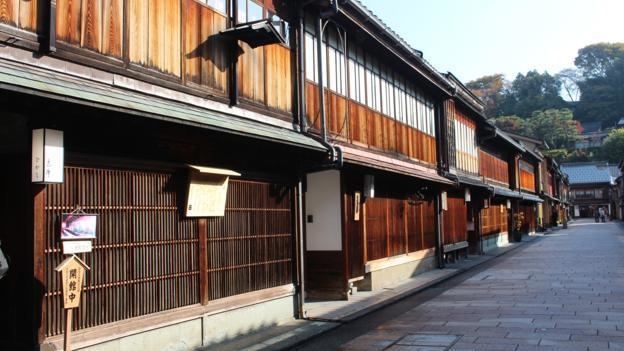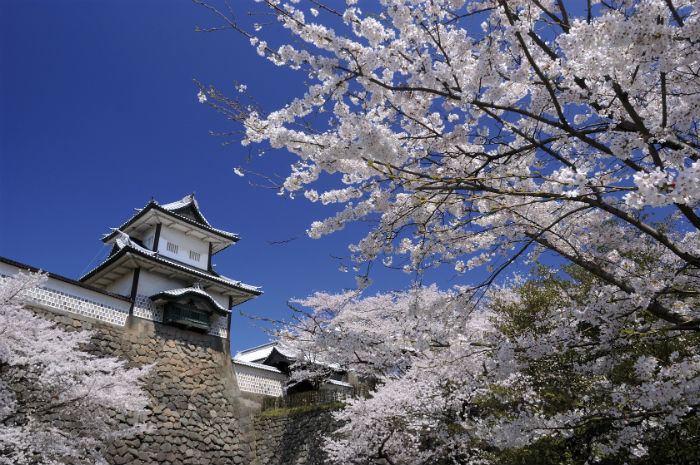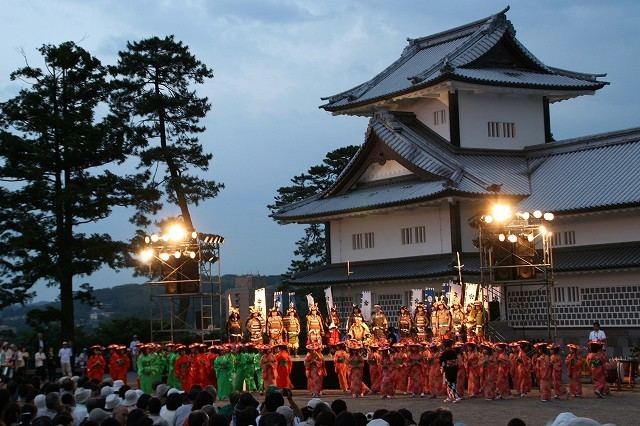Country Japan Population 462,361 (2010) Area 467.77 km2 | Region ChubuHokuriku Mayor Yukiyoshi Yamano (since December 2010) | |
Points of interest Kenroku-en, 21st Century Museum of Contemporary Art - Kanazawa, Ishikawa Prefectural Museum of Art, Kanazawa Castle, Mount Utatsu Colleges and Universities Kanazawa University, Kanazawa College of Art, Kanazawa Seiryo University, Kanazawa Gakuin University, Hokuriku University | ||
For other uses, see Kanazawa (disambiguation).
Contents
- Map of Kanazawa
- Discover kanazawa city japan
- History
- Geography climate and population
- Culture
- Points of interest
- Local cuisine
- References
Map of Kanazawa
Kanazawa (, Kanazawa-shi) is the capital city of Ishikawa Prefecture, Japan.
Discover kanazawa city japan
History

The name "Kanazawa" (??), which literally means "marsh of gold", is said to derive from the legend of the peasant Imohori Togoro (lit. "Togoro Potato-digger"), who was digging for potatoes when flakes of gold washed up. The well in the grounds of Kenrokuen known as Kinjo Reitaku (????)was recreated by the Maeda lords to acknowledge these roots. The area where Kanazawa is was originally known as Ishiura, and the Ishiura Shrine near Kenrokuen is a remnant of this period.

The centre of the castle town was the castle. While many castle towns in Japan had the castle placed to one side of the city, Kanazawa spread out concentrically from the castle site. Kanazawa Castle itself largely burned down in 1888, but there are a few buildings remaining, notably the Ishikawa Gate and the Sanjikken Longhouse, and one large section has been painstakingly rebuilt to authentic standards of construction. The castle site dates back to the fifteenth century, when it was the centre of power for the Ikko-ikki, which was a Buddhist sect that had overthrown the old regional governors, the Togashi clan, and established what is called "The Peasants Kingdom" in the district of Kaga, the southern part of present-day Ishikawa Prefecture.
During the fifteenth century, the powers of the central Shoguns in Kyoto was waning, and their regional governors were assuming even greater powers, carving out their own little fiefs. In Kaga, the priest Rennyo, of the Jodo Shinshu sect, arrived in the Kaga region to proselytise. Rennyos brand of Buddhism quickly spread among the samurai and peasants. The followers of Rennyo were directly under the control of the central Honganji in Kyoto, and were known as the Ikko sect, the "Single-Minded" sect. At the time, due to the diminishing power of the hereditary regional governors, the Togashi, central control over the region was weak, which allowed groups of Rennyo converts to increase their political ambitions, leading to the suicide of the last Togashi governor in 1488.
Geography, climate, and population

Kanazawa sits on the Sea of Japan, bordered by the Japanese Alps, Hakusan National Park and Noto Peninsula National Park. The city sits between the Sai and Asano rivers. Its total area is 467.77 km2 (180.61 square miles).
Culture

Hyakumangoku Matsuri and Asano-gawa Enyukai are the major festivals held in Kanazawa.
Kanazawa-Haku is gold which is beaten into a paper-like sheet. Gold leaf plays a prominent part in the citys cultural crafts, to the extent that there is a gold leaf museum (Kanazawa Yasue Gold Leaf Museum). It is found throughout Kanazawa and Ishikawa, and Kanazawa produces 99% of Japans high-quality gold leaf: the gold leaf that covers the famous Golden Pavilion in Kyoto was produced in Kanazawa. Gold leaf is even put into food. The city is famous for tea with gold flakes, which is considered by the Japanese people to be good for health and vitality. Kanazawa lacquerware (Kanazawa shikki), a high-quality lacquerware traditionally decorated with gold dust, is also well-known.
Cultural landscape in Kanazawa. Tradition and culture in the castle town has been designated an Important Cultural Landscape.
Points of interest
Kanazawa was one of the few major Japanese cities to be spared USAAF fire bombing during World War II. As a result, Kanazawas considerable architectural heritage has been preserved.
Kenrokuen Garden is by far the most famous part of Kanazawa. Originally built as the outer garden of Kanazawa castle, it was opened to the public in 1875. It is considered one of the "three great gardens of Japan" and is filled with a variety of trees, ponds, waterfalls and flowers stretching over 25 acres (10 ha)). In winter, the park is notable for its yukitsuri – ropes attached in a conical array to trees to support the branches under the weight of the heavy wet snow, thereby protecting the trees from damage.
Outside Kenrokuen is Ishikawa-mon, the back gate (karamate-mon) to Kanazawa Castle. The original castle was largely destroyed by fire in 1888 but part of it was partially restored as of 2001, with more to come. There are plans to re-create much of the original castle grounds, including some surrounding areas.
The Seisonkaku Villa was built in 1863 by a Maeda lord, Maeda Nariyasu (13th Lord) for his mother, Takako. It was originally called Tatsumi Goten (Tatsumi Palace). Much of it has been dismantled, but what remains is one of the most elegant remaining feudal lord villas in Japan. The villa stands in a corner of Kenrokuen; separate admission fees (¥700) apply. Notable features are the vividly coloured walls of the upper floor, with purple or red walls and dark-blue ceilings (red walls—benigara—are a Kanazawa tradition), and the custom-made English carpet in the audience chamber.
Kanazawa boasts numerous Edo period (1603–1867) former geisha houses in the Higashi Geisha District, across the Asano river (with its old stone bridge) out from central Kanazawa. Nearby is the Yougetsu Minshuku which sits at one end of one of the most photographed streets in Japan.
This area retains, almost completely, the look and feel of pre-modern Japan, its two-story wooden facades plain and austere. The effect is accentuated by the early morning mist. At night, the street is lit by recreated Taisho-period streetlamps.
The Oyama-jinja shrine, which is considered an Important Cultural Asset, is also in Kanazawa. It is noted for its imposing three-story Shinmon gate influenced by Dutch design, built in 1875, with its brightly coloured stained-glass windows.
Kanazawas Myoryuji Temple or Ninja-dera (Ninja Temple) is a fascinating amalgamation of traditional temple architecture, hidden doors, passageways, and hidden escape routes. Although the temple is often referred to as ninja dera, it is not connected with ninjas at all. (This does not stop local tour operators and shops from selling ninja trinkets.) Local legend has it that the temple, with its hidden doors and passageways, was intended as a secret refuge for the local rulers in the case of an external threat.
Mount Utatsu gives a commanding view of the city of Kanazawa. Toyokuni Shrine, Utatsu Shrine (a Tenman-gu), and Atago Shrine, known together as the Mount Utatsu Three Shrines, are found on the mountain. A monument to author Shusei Tokuda is located near the summit.
Local cuisine

Kanazawa is known for its traditional Kaga Cuisine. Seafood is a specialty, jumbo shrimp, followed by sushi and sashimi. The sake produced in this region is of high quality, smooth and sweet, derived from the rice grown in Ishikawa Prefecture as well as the considerable precipitation of the Hokuriku region, allowing for an ample supply of clean, fresh water. Omicho market is a market in the middle of the city, originally open-air, and now covered, which dates back to the Edo period. Most of the shops there sell seafood.
